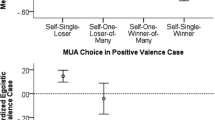Abstract
The paper reports the results of an ultimatum game experiment designed to test the effects of meritocratic norms on individual behavior and aggregate outcomes. In one treatment the roles of proposer and responder were assigned randomly. In the other treatment the roles were earned in a general knowledge quiz. The results show that proposers offer significantly less when they have earned their roles and responders have a significantly lower acceptance threshold. Rejection rates are lower for offers lower than the equal split when positions are allocated based on merit: Proposers earn significantly more in this setting. Responders suffer some loss in this treatment. This leads to an increase in overall inequality of payoffs measured by the Gini index when positions are allocated based on merit.




Similar content being viewed by others
Notes
For the remainder of this paper the female form will be used for the proposer and the male form for the responder.
For an overview on social preferences see Fehr and Fischbacher (2002).
By assigning a social position based on merit, it is possible that status linked to the earned social position is created in the process. This would mirror the fact that different occupational positions are associated with different levels of status (Ganzeboom et al. 1992). If we follow this line of argument, the preferred social position is also the higher status position. Then distribution norms described for example by Homans (1958) would indicate that a higher status should correspond with the allocation of a larger amount of the good in question.
There is evidence that subjects’ behavior can differ when a game is played using the strategy method and when the direct response technique is used (see e.g. Brandts and Charness 2000, 2011). When comparing the behavior of subjects in two treatments this would however only be a problem if subjects in the two treatments reacted differently to the strategy method (for a similar argument see Falk et al. 2008).
The German questionnaire used in the experiment and an English translation can be found here (accessed on 8.3.2015): http://vlab.ethz.ch/svo/SVO_Slider/SVO_Slider.html.
See Appendix 7.1 for the procedure used to derive the values of the parameter \(\alpha \).
For an overview on measurement methods for social preferences see Murphy and Ackermann (2014).
Both correlations are qualitatively similar if calculated for each treatment separately.
References
Ackermann KA, Fleiß J, Murphy RO (2014) Reciprocity as an individual difference. J Conflict Resolut. doi:10.1177/0022002714541854
Andreoni J, Castillo M, Petrie R (2003) What do bargainers’ preferences look like? Experiments with a convex ultimatum game. Am Econ Rev 93(3):672–685. doi:10.1257/000282803322157034
Arvey RD, Renz GL (1992) Fairness in the selection of employees. J Bus Ethics 11(5–6):331–340. doi:10.1007/BF00870545
Ball S, Eckel C, Grossman PJ, Zame W (2001) Status in markets. Q J Econ 116(1):161–188. doi:10.1162/003355301556374
Ball S, Eckel C (1998) Stars upon thars: status and discrimination in ultimatum games. http://citeseerx.ist.psu.edu/viewdoc/download?doi=10.1.1.130.2412&rep=rep1&type=pdf
Balliet D, Parks C, Joireman J (2009) Social value orientation and cooperation in social dilemmas: a meta-analysis. Group Process Intergroup Relat 12(4):533–547. doi:10.1177/1368430209105040
Blanco M, Engelmann D, Normann HT (2011) A within-subject analysis of other-regarding preference. Games Econ Behav 72(2):321–338. doi:10.1016/j.geb.2010.09.008
Bolton G, Ockenfels A (2000) ERC: a theory of equity, reciprocity, and competition. Am Econ Rev 90(1):166–193. doi:10.1257/aer.90.1.166
Brandts J, Charness G (2000) Hot vs. cold: sequential responses and preference stability in experimental games. Exp Econ 2(3):227–238. doi:10.1023/A:1009962612354
Brandts J, Charness G (2011) The strategy versus the direct-response method: a first survey of experimental comparisons. Exp Econ 14(3):375–398. doi:10.1007/s10683-011-9272-x
Breaugh JA (2003) Effect size estimation: factors to consider and mistakes to avoid. J Manag 29(1):79–97. doi:10.1177/014920630302900106
Breen R, Goldthorpe J (2001) Class, mobility and merit the experience of two british birth cohorts. Eur Sociol Rev 17(2):81–101. doi:10.1093/esr/17.2.81
Cherry TL (2001) Mental accounting and other-regarding behavior: evidence from the lab. J Econ Psychol 22(5):605–615. doi:10.1016/S0167-4870(01)00058-7
Cherry TL, Frykblom P, Shogren JF (2002) Hardnose the dictator. Am Econ Rev 92(4):1218–1221. doi:10.1257/00028280260344740
Cook KS, Hegtvedt KA (1983) Distributive justice, equity, and equality. Ann Rev Sociol 9:217–241. doi:10.1146/annurev.so.09.080183.001245
Cook KS, Parcel TL (1977) Equity theory: directions for future research. Sociol Inquiry 47(2):75–88. doi:10.1111/j.1475-682X.1977.tb00781.x
Dahrendorf R (2010) Homo Sociologicus: Ein Versuch zur Geschichte, Bedeutung und Kritik der Kategorie der sozialen Rolle. VS Verlag für Sozialwissenschaften, Wiesbaden
Diekmann A (2008) Soziologie und Ökonomie: Der Beitrag experimenteller Wirtschaftsforschung zur Sozialtheorie. Kölner Zeitschrift für Soziologie und Sozialpsychologie 60(3):528–550. doi:10.1007/s11577-008-0026-5
Diekmann A, Przepiorka W, Rauhut H (2011) Die Präventivwirkung des Nichtwissens im Experiment. Zeitschrift für Soziologie 40(1):74–84
Durkheim É (1995) Die Regeln der soziologischen Methode. Suhrkamp, Frankfurt am Main
Elkins TJ, Bozeman DP, Phillips JS (2003) Promotion decisions in an affirmative action environment: Can social accounts change fairness perceptions? J Appl Soc Psychol 33(6):1111–1139. doi:10.1111/j.1559-1816.2003.tb01941.x
Falk A, Fischbacher U (2006) A theory of reciprocity. Games Econ Behav 54(2):293–315. doi:10.1111/1468-0297.00027
Falk A, Fehr E, Fischbacher U (2008) Testing theories of fairness–intentions matter. Games Econ Behav 62(1):287–303. doi:10.1016/j.geb.2007.06.001
Fehr E, Fischbacher U (2002) Why social preferences matter—the impact of non-selfish motives on competition, cooperation and incentives. Econ J 112(478):C1–C33. doi:10.1111/1468-0297.00027
Fehr E, Fischbacher U (2004) Social norms and human cooperation. Trends Cogn Sci 8(4):185–190. doi:10.1016/j.tics.2004.02.007
Fehr E, Fischbacher U (2004b) Third-party punishment and social norms. Evol Human Behav 25(2):63–87. doi:10.1016/S1090-5138(04)00005-4
Fehr E, Gintis H (2007) Human motivation and social cooperation: experimental and analytical foundations. Ann Rev Sociol 33:43–64. doi:10.1146/annurev.soc.33.040406.131812
Fehr E, Schmidt K (1999) A theory of fairness, competition, and cooperation. Quart J Econ 114(3):817–868. doi:10.1162/003355399556151
Fischbacher U (2007) z-Tree: zurich toolbox for ready-made economic experiments. Exp Econ 10(2):171–178. doi:10.1007/s10683-006-9159-4
Fleiß J (2012) Handlungstheorien und Theorieverständnis in der methodologisch-individualistischen Tradition. Deren Wandel und der Bezug zur Wirklichkeit. In: Schülein A, Angermann G (eds) Handlung. Neue Versuche zu einem klassischem Thema, VS Verlag für Sozialwissenschaften, Wiesbaden. doi:10.1007/978-3-531-18792-1_6
Fleiß J, Leopold-Wildburger U (2012) Social values and cooperation. Results from an iterated prisoner’s dilemma experiment. In: Klatte D, Lüthi HJ, Schmedders K (eds) Operations research proceedings 2011. Springer, Berlin, pp 199–204. doi:10.1007/978-3-642-29210-1_32
Fleiß J, Palan S (2013) Of coordinators and dictators: a public goods experiment. Games 4(4):584–607. doi:10.3390/g4040584
French JR, Raven B (2001) The bases of social power. In: Asherman IG, Asherman SV (eds) The negotiation sourcebook. HRD Press, Amherst, pp 61–74
Gächter S, Riedl A (2005) Moral property rights in bargaining with infeasible claims. Manage Sci 51(2):249–263. doi:10.1287/mnsc.1040.0311
Ganzeboom HB, Graaf PMd, Treiman DJ (1992) A standard international socio-economic index of occupational status. Soc Sci Res 21(1):1–56. doi:10.1016/0049-089X(92)90017-B
Goldhamer H, Shils EA (1939) Types of power and status. Am J Sociol 45(2):171–182. doi:10.1086/218263
Greiner B (2004) An online recruitment system for economic experiments. In: Kremer K, Macho V (eds) Forschung und wissenschaftliches Rechnen 2003. GWDG Bericht 63, Ges. für Wiss. Datenverarbeitung, Göttingen, pp 79–93
Güth W, Tietz R (1990) Ultimatum bargaining behavior. A survey and comparison of experimental results. J Econ Psychol 11(3):417–449. doi:10.1016/0167-4870(90)90021-Z
Güth W, Schmittberger R, Schwarze B (1982) An experimental analysis of ultimatum bargaining. J Econ Behav Organ 3(4):367–388. doi:10.1016/0167-2681(82)90011-7
Hoffman E, McCabe K, Shachat K, Smith V (1994) Preferences, property rights, and anonymity in bargaining games. Games Econ Behav 7(3):346–380. doi:10.1006/game.1994.1056
Homans GC (1958) Social behavior as exchange. Am J Sociol 63(6):597–606. doi:10.1086/222355
Jenkins SP (2006) Svylorenz: stata module to derive distribution-free variance estimates from complex survey data, of quantile group shares of a total, cumulative quantile group shares. http://ideas.repec.org/c/boc/bocode/s456602.html#biblio
Jenkins SP (2010) Ineqdeco: stata module to calculate inequality indices with decomposition by subgroup. http://ideas.repec.org/c/boc/bocode/s366002.html
Liebe U, Tutic A (2010) Status groups and altruistic behaviour in dictator games. Ration Soc 22(3):353–380. doi:10.1177/1043463110366232
Murphy R, Ackermann K (2014) Social value orientation: theoretical and measurement issues in the study of social preferences. Personal Soc Psychol Rev 18(1):13–41. doi:10.1177/1088868313501745
Murphy R, Ackermann K, Handgraaf M (2011) Measuring social value orientation. Judgm Decis Making 6(8):771–781
Oosterbeek H, Sloof R, van de Kuilen G (2004) Cultural differences in ultimatum game experiments: evidence from a meta-analysis. Exp Econ 7(2):171–188. doi:10.1023/B:EXEC.0000026978.14316.74
Oxoby RJ, Spraggon J (2008) Mine and yours: property rights in dictator games. J Econ Behav Organ 65(3–4):703–713. doi:10.1016/j.jebo.2005.12.006
Rauhut H, Winter F (2010) A sociological perspective on measuring social norms by means of strategy method experiments. Soc Sci Res 39(6):1181–1194. doi:10.1016/j.ssresearch.2010.06.009
Selten R (1967) Die Strategiemethode zur Erforschung des eingeschränkten rationalen Verhaltens im Rahmen eines Oligopolexperimentes. In: Sauermann H (ed) Beiträge zur experimentellen Wirtschaftsforschung. J.C.B. Mohr, Tübingen, pp 136–168
Sen A (2000) Merit and justice. In: Arrow K, Bowles S, Durlauf S (eds) Meritocracy and economic inequality. Princeton University Press, Princeton, pp 5–16
Tutic A, Liebe U (2009) A theory of status-mediated inequity aversion. J Math Sociol 33(3):157–195. doi:10.1080/00222500902799601
Vieth M (2003) The evolution of norms of fairness in the ultimatum game—a game theoretical model. Zeitschrift für Soziologie 32(4):346–367
Visser MS, Roelofs MR (2011) Heterogeneous preferences for altruism: gender and personality, social status, giving and taking. Exp Econ 14(4):490–506. doi:10.1007/s10683-011-9278-4
Young M (1962) The rise of the meritocracy 1870–2033. Penguin, Harmondsworth
Author information
Authors and Affiliations
Corresponding author
Additional information
My thanks go to Simon Gächter for providing the knowledge quiz questions, Manuela Vieth, Ulrike Leopold-Wildburger, Stefan Palan and Chris Snijders for feedback on the paper draft. I also thank audiences at the Research Seminar of the Faculty of Social and Economic Sciences at the University of Graz, the Conference on New Developments in Signaling and Game Theory in Ascona and the members of the Chair of Sociology at ETH Zurich for valuable comments.
Appendix
Appendix
1.1 Computation of the alpha-parameter
For cases where player \(i\) has a lower payoff \(x_i\) than the payoff \(x_j\) of player \(j\), Fehr and Schmidt (1999) put forward the following utility function:
The parameter \(\alpha _i\) captures the aversion of player \(i\) against disadvantageous inequality. The lowest offer accepted by a responder allows us to derive his \(\alpha \)-value since somewhere between the lowest offer \(o_i\) a responder is willing to accept and the offer \(o_i-1\) which he rejects he is indifferent between the rejection payoff and accepting the offer. We assume that this indifference point lies at \(o_i-0.5=x_i\). We set \(x_i-\alpha _i \cdot (x_j-x_i)=0\) and \(x_j=20-x_i\) and this simplifies to
used to estimate \(\alpha _i\). Since the maximum value of \(o_i\) is 10, the maximum value of \(x_i=o_i-0.5=9.5\) and no division by zero can occur. This procedure is identical to the one used by Blanco et al. (2011).
Rights and permissions
About this article
Cite this article
Fleiß, J. Merit norms in the ultimatum game: an experimental study of the effect of merit on individual behavior and aggregate outcomes. Cent Eur J Oper Res 23, 389–406 (2015). https://doi.org/10.1007/s10100-015-0385-8
Published:
Issue Date:
DOI: https://doi.org/10.1007/s10100-015-0385-8




